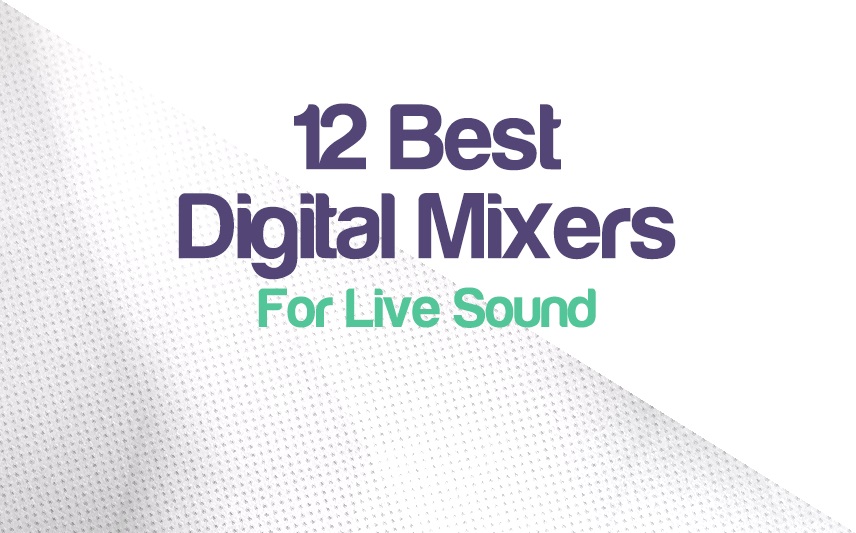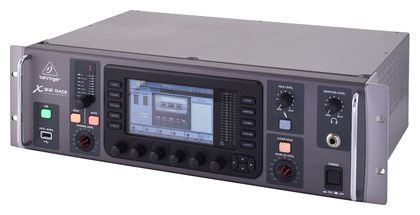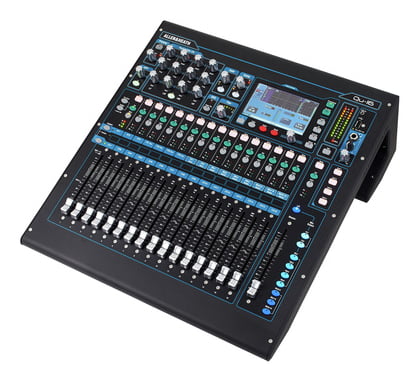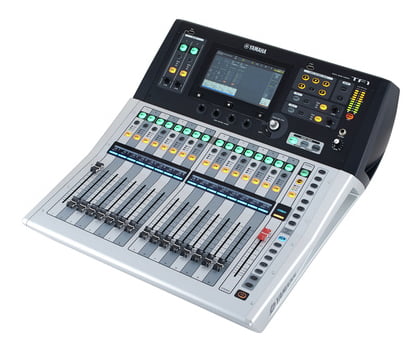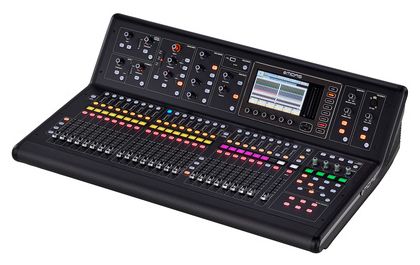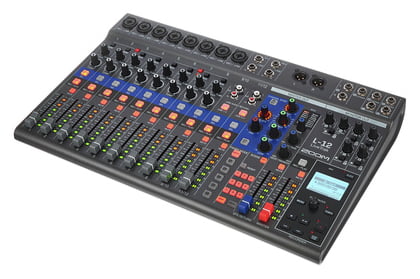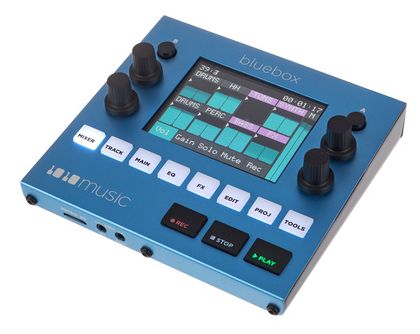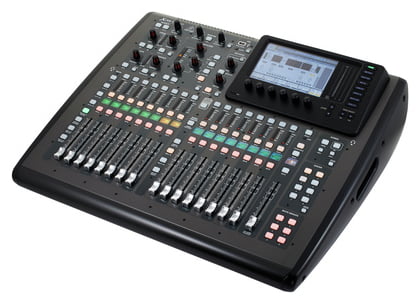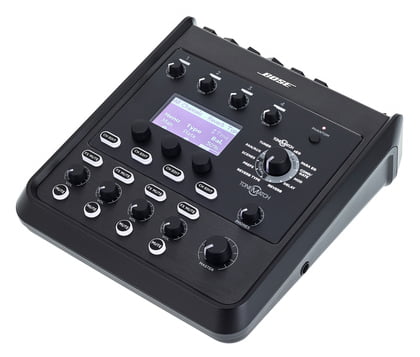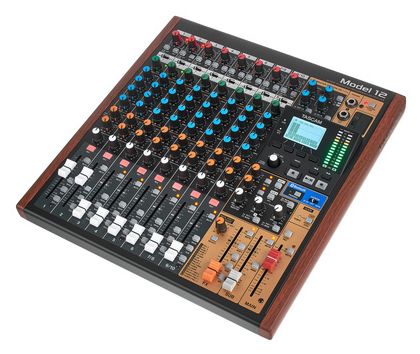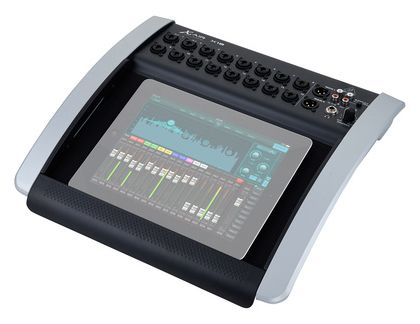There are many digital mixers that you could use, though we tried our best to find the best mixers for live sound.
The audio mixer has long been a very handy device in the sound engineer’s arsenal. The mixer is a processor that takes input from multiple microphones, instruments, and sound devices, allows you to manipulate the sound signals by applying EQs and effects, and then sends the sound to multiple output devices.
The analog mixer is slowly becoming a thing of the past. You get more power, flexibility, and control over your sound with the introduction of digital mixers. You can now choose from a barrage of options at different price points.
With digital effects, futuristic preamps, processing muscle, and unlimited input/output options, you can get very close to your idea of the perfect sound.
Before buying a digital mixer, there are many factors that you need to look at. First, you need to clearly know the number of microphones and instruments you need to connect the mixer.
If your requirement is based on more mics than line instruments, you’ll need a mixer that has enough microphone preamps built into the unit and phantom power to power them.
If it’s the other way around, you must ensure that the mixer has enough line input slots available. You may also look for a mixer that has combo ports so that you have the freedom to connect a microphone or any sort of instrument to it.
Secondly, you need to know how many output options you require and the type of ports you’ll need to connect to those output devices. Finally, if you’re keen on spending less on external gear like pedals and effects, you can look for a mixer with a solid effects processor.
With all of that being said, let’s dive into our list:
The 12 Digital Mixers For Live Sound 2024
1. Behringer X32 Rack
The Behringer X32 Rack has a unique interface spruced up by its 5-inch colored screen.
Strangely enough, you will not find any faders on the front panel. The separate section for your channels, like what was offered by its predecessor, the X32 producer, is also missing.
However, the X32 makes up for this deficiency by providing unique and innovative options to interact with the device. Behringer X32 gives total control of all major functions wirelessly via mobile connectivity.
The X32 is a versatile digital mixer and can be used to mix sound for small-scale gigs as well as for larger liver performance setups. The device is compatible with audio data network protocols like Ultranet and AES50.
In addition, it has a USB port on the back for connecting to a computer and one on the front to record directly on a USB storage device which is a very handy feature.
Key Features:
- Innovative Front Interface
One of the definitive features of a mixer is its faders. The X32 is a digital mixer that has no faders. Instead, it allows your mobile device to adjust each channel digitally. So if you’re not near a computer and find yourself in a situation where you need to mix sound, your iPad or iPhone can connect to the X32 with an app eliminating the need to have a system nearby.
In addition, all major functions can be directly controlled from the front panel and monitored through the crisp 5inch display. The user-facing interface is aesthetically pleasing and has only 2 output options, one for your headphones and the other for your USB drive.
- Channels and Connectivity
The Behringer X32 is 40 input mixer with 25 buses, so you know it can handle mega-sized events. The mixer’s connectivity options can be further increased by combining it with Behringer’s digital snake.
Its rugged body also houses a 32 x 32 USB card for recording and playback. In addition, the back panel has a separate port to connect personal monitors if you want to monitor the sound in a studio or live setup.
- Built-in Effects Processor
The Behringer X32 has a dedicated “Effects” button on the front panel, which opens up a stereo effects processor with 8 storage slots. This allows you to apply EQs, delays, compressions, and reverbs to your mix via the encoders on the front panel.
In addition, the processor can simulate the infamous EMT’s effects, its variations, and the famous Lexicon reverbs/delays.
- Apple Apps for Wireless Connectivity
With the X32 mix app, you can connect your iPad to the digital mixer and have wireless controls at your fingertips. The application can be downloaded for free from the Apple store. The app’s interface shows all the main menus and sub-menus you see on the front panel and is fully capable of controlling all the features the X32 offers.
There is also an X32 Edit app available for download, allowing you to edit your mix easily. The app is compatible with all operating systems, including Mac, Windows, and Linux.
- Preamps and Latency
The 16 mic preamps on the back panel of the X32, combined with the intuitive floating point Digital Signal Processing (DSP) feature, provide great sound quality and extremely low latency of just 0.8 ms, which is unnoticeable.
- Saving Scenes
A clever feature found in the X32 mix app can be explored in the “Scene” tab. Here you can take an image of your mix along with whatever adjustments/manipulations have been made over it, including all effects that have been applied and the levels of different digital faders.
This means that you can save and recall 100 scenes or mixes, which saves time and adds efficiency to your mixing.
Pros:
The front panel is very organized and user-friendly without the clutter of too many knobs and buttons. The X32 apps make things easy by providing wireless controls on the go.
The effects processor on board is very handy and can transform the sound of your mix. The scene-saving option allows you to pick up from where you left off and adds value to the mixing experience.
Cons:
A slightly larger screen with a touch option would save time and improve the user experience. The X32 app tends to be a bit laggy at times.
You may experience digital noise from some of the output channels. Some features could be simplified instead of hitting multiple button combinations to achieve the desired result.
2. Allen & Heath Qu-16 Chrome
Out of all the products that Allen & Heath have designed and released, the Qu-16 Chrome is their best seller.
When talking about the Qu-16, the main focus has been on making it easy to use. The mixer is nicely built, and the angled ergonomic design sits well on your mixing desk. The faders are automated and instantly take place when different settings are recalled.
The Qu-16 also connects with your iPad to bring the controls to your fingertips without a network of wires getting in the way.
The colored display also allows you to adjust controls via touch. In addition, the graphical interpretations of various frequencies and signal strengths are depicted on the display through colorful spectrograms, making it easier for the user to judge at a glimpse what adjustments need to be made.
Key Features:
- Easy Transition
The Qu-16 is designed in such a way that it makes the transition easy for beginners as well as users who want to make the shift from an analog mixer to a digital one. All the major controls are right in front, so you don’t need to scroll through multiple digital menus to get o where you need to be.
There are 16 faders on the front with corresponding input channels and controls for each input. Each channel can be muted, selected, or soloed with a touch of a button.
- Inputs/Outputs
As the name suggests, the Allen & Heath Qu-16 Chrome has 16 inputs and 10 XLR outputs on the back panel. To save space, the interface is designed so that you can also use the same master control, faders, and levels to adjust your output controls by pressing the relevant button.
- Recall Feature
All the different settings available, including the preamp settings, the levels, and the faders or each channel, can be saved and recalled. When the relevant button is pressed, the faders magically move to where they were during the last saved setting, making the operation futuristic and appealing.
- Colored Touch Screen Display
The Qu-16 has a touch screen color display for your fine tuning and tweaking needs. The user can use the available physical knobs on the front panel, which will show a helpful data knob adjusting to the changes. The same can be done directly from the touch screen.
- 4 Band EQ and HPF
There is a 4 band EQ with “Gain,” “Frequency,” and “Width” knobs that, when moved, show corresponding visualizations on the touch screen.
The device also features a High Pass Filter which removes any unwanted frequencies from the sound, but what is different about the HPF is that instead of an on/off button that is commonly seen, you get a knob to adjust the frequency exactly the way you like.
- Effects Processor
The Qu-16 has a built-in effects processor with a vast library of 80 effects. The processor allows the user to apply 4 effects at a time simultaneously. This can be done by pressing the dedicated “Effects” button.
In doing so, the display shows the relevant graphic interface depending on what effect is applied, such as delays and reverbs. A built-in processor allows you to travel light as you may not need to carry effect-related hardware with the Qu-16 on hand.
- Qu Port
Connecting your USB storage device directly with the Qu Port on the front will turn the drive into a multi-track recorder that will record in waveform. This way, you can record the sound check session of your band and play around with the mixer to get the levels right while the band takes 5.
This concept is called virtual sound check. You also have a playback option, so you could have some music to play in the background when the band takes a little break.
Pros:
Allen and Health’s Qu-16 is very strongly built. It has been designed so users of all levels can familiarize themselves with it and get going relatively easily. The sound quality is exceptional.
The option to record and playback multi-track audio thanks to the Qu port is a feature that adds convenience and reliability to the user experience. In addition, the built-in effects process reduces your hardware load.
Cons:
The mixer has some significant issues like static which eventually gets mixed with the tracks when plugged into a USB 3.0. It may give out a windy/hum sound when the power is on, and nothing is playing.
The front faders may become non-responsive at times which can only be corrected by turning the device off and resetting it.
3. Presonus StudioLive 32SC
The Presonus StudioLive 32 SC is riddled with versatile features yet very easy to use.
Regarding performance and stability, the 32 SC has solid processing power. It operates on a dual-core engine that can simultaneously power up to 286 processors.
Having this much power under the hood, the Studio Live houses Fat Channel plug-ins that can be applied on every channel or bus (26 mix buses) on board the SC 32.
The 32 SC is a stable device with versatile features, making it suitable for home studios and larger-scale live event setups. With all the input and output options available, it would be impossible to find a mixing/recording situation that you are not prepared for.
The Presonus Studio Live comes with the Studio One and Studio Magic software bundle, eliminating the need to purchase DAWs or plug-ins.
Key Features:
- Input/Output Options
A 32-channel Presonus StudioLive 32 SC is loaded with input and output options. The back panel includes 32 mic preamps, out of which the first 8 are regular preamps, and the remaining 8 are combo ports giving the option of connecting mics in the available preamps or any other line-in instrument of your choice.
Also included on the back panel are 6 XLR outputs for your monitors and other sound output devices. On the back of the Presonus StudioLive 32, you also get an AED connector, an audio network port to connect with stage boxes, and an Ethernet port to connect directly to a router. Lastly, there is a USB port you can use to record as many as 64 channels of USB.
- Front Interface
The most catchy feature of the user interface is perhaps the 7-inch colored touch screen display that makes adjusting various parameters easy. The panel has 17 automated faders, one master, and 16 faders for the 16 available input channels.
In addition, a “Fat Channel” section allows you to change the selected channel’s gain, panning, noise gate, and compression. You also get a High Pass Filter (HPF) knob to cut out unwanted frequencies and a 4-band (low, low mid, high mid, and high) EQ which includes Frequency, Q, and Bandwidth controls.
- Built-in Plugins
On the front panel’s “Fat Channel” area, you will also find a bunch of plug-ins modeled after old analog versions of compressors and EQs. These are available for application on not only your inputs but your outputs and master output as well.
- Software Bundle
The addition of the Studio One Artist and Studio Magic Plugin software bundle increases the value of the overall package that the Presonus StudioLive offers. You get all the Fat Channel plug-ins on the Studio One Artist and have a large library of additional plug-ins available in Studio Magic.
Some special plug-ins include the Lexicon reverb and Brainworx compressor, among many others.
- A/B Option
An interesting feature of the 32 SC is the Fat Channel A/B button that allows you to store two types of settings on a channel. This can be especially handy if your band member wishes to change his guitar in the middle of a show and needs an EQ change for the second guitar.
Instead of going through the hassle of importing previously saved settings, one can have two different settings and toggle between them with the A/B button.
- Options for Recording
The 32 SC gives you plenty of options to record your mixes. You have an SD slot to record directly on an SD card. You also have the option to playback audio from an SD card. You can connect your Presonus device to a computer via USB and have 64 channels for playback and recording.
Plugging into the Ethernet port also gives you options to connect to studio boxes or personal mixers for recording purposes.
Pros:
The software bundle that comes with the 32 SC gives you all you need to get going. The Fat Channel offers many effects like reverb, compression, and EQ and includes several famous effects plug-ins of the past to help you transform your sound.
In addition, multiple recording options are available for the user, including an SD card, recording on your computer via USB, and the Ethernet port.
Cons:
Like most mixers with motorized faders, there might be times when the faders become unresponsive, leading you to restart or reset your device to regain proper functionality and control. Projects cannot be edited offline. The same goes for the saved scenes.
4. Soundcraft Ui24R
The Soundcraft Ui24R looks very different from the digital mixers discussed thus far.
Contrary to other digital mixers that connect to a computer through a USB port, the Ui24R has a unique approach. It has a built-in dual-band router which can be found in the wifi list of your computer and connects wirelessly when selected.
The device does not have any colored touch screen display. Instead, it uses your computer’s web browser to show its interface.
The design of the Soundcraft Ui24R is also quite different from what you may find on other digital mixers. Except for the built-in router’s antenna, there is nothing on the back, while all the inputs and outputs you would normally find on the back panel of a mixer are front facing.
Despite the peculiar design, however, the device has all the features of a fully functional mixer.
Key Features:
- Front Panel Input/Outputs
The front of the Ui24R is loaded with input/output options. There are 20 mic line inputs, out of which 10 are combo jacks to connect any combination of mics, instruments, and sound input devices.
There are 8 line outputs that you can use to connect to amplifiers and monitors, and next to it is your master output that connects to the PA system. You get an input option for connecting an iPod or CD player to play music, and there is also a USB port to play Mp3 or Wav files directly from a USB storage device.
A 32-channel USB streaming port can stream audio to and from the unit, and yet another USB port for recording 24 channels simultaneously into a USB storage device.
- Dual Band Router and Software Integration
The built-in dual-band router is what connects any wireless device to the mixer. All you need to ensure is that the device you wish to connect to the mixer has a web browser because the mixer’s GUI will essentially open by visiting ui.io in your web browser.
The web browser interface is very lightweight and doesn’t demand much from the processing unit of your device. This is why 10 devices can be hooked up to the router at any time to adjust their relevant aspects.
- The Web Browser Interface
Once you connect to ui.io, you will land on the mix mode screen, where you’ll see all your input channels with a corresponding fader for each. You will also see your USB controls. You have well-labeled digital buttons to toggle between mix mode and gain mode.
The gain mode lets you set levels and switch on the phantom power for your mic inputs, among other things. You get another toggle button to switch to your aux bus page, where you get access to the 8 aux buses theUi24R offers.
- Builtin Effects Processor
A separate “FX” button takes you to the 4 effects channels on which you can set various effects. By default, the 4 available effects are 2 different reverbs and a delay. The effects can be further manipulated through the edit mode to achieve the desired results.
- In-Depth Editing
Selecting any channel and hitting the “Edit” button opens a whole array of parameters that can be changed. You get access to a 3-band EQ with high pass and low pass filters, a noise gate, compressor, further fx editing, and aux bus controls.
Another tab found on the first 2 channels allows access to several amp simulations provided by DigiTech. This allows you to leave your amps behind, as these digital amps sound pretty close to the real thing.
Pros:
The router-based connectivity is a smart way to connect and eliminates lengthy software installations to start working.
The GUI is web-based, and you’ll find it on your browser. DigiTech’s amp simulations present in the digital UI can come in handy if you want to carry bulky amplifiers as you travel.
Cons:
The built-in router is unreliable and may drop signals creating problems for your home studio and live setups. Using a web browser-based user interface is not everyone’s cup of tea.
Some sound engineers may prefer the touch of tangible faders at their fingertips rather than getting lost in the scrolling to find the channel they want to edit.
5. Yamaha TF1
The Yamaha TF-1 is the most basic of the Touch Flow series mixers, including the TF-1, TF-3, and the TF-5.
The “Touch Flow” concept introduced through these mixers promises a reliable, intuitive, and efficient way to adjust various parameters/controls through a combination of the physical controls and the multitouch colored screen.
In addition, the TF-1 focuses on giving the user a customizable device that can change or reassign functions to various buttons on the front panel.
The touch and turn knob is a unique feature that can help a beginner-level engineer get to his desired sound quicker. This new feature can impress the more tech-savvy engineer as it saves time and adds efficiency.
The touch and turn mode can be easily switched off to give the user a more hands-on ability to change parameters.
Key Features:
- Front/Back Panels
The TF-1 has 16 combo inputs and 16 Omni outputs at the back of the unit. Outputs 15 and 16 act as your master outputs by default, but these ports are programmable and can be changed to act differently.
There is an empty slot at the back of the device where a Dante card can be inserted to enable connectivity to a studio box via cat 5 cables. The front panel has 1 master fader and 16 mechanical faders corresponding to each of the 16 mic preamps at the back. The multitouch display allows you to change several key features through touch, for instance, recalling a save scene from the scene list menu.
Next to the display, you will find a couple of stereo input controls for the RCA connectors on the back panel. There are several user-assignable keys around the screen that can be programmed according to the sound engineer’s requirements to make changes quickly and efficiently.
There are 2 fully editable effects processors which are easy to adjust through dedicated controls. A couple of one-touch buttons help mute your inputs and effects. A display strip runs through the front panel showing details of each channel.
- Quick Pro Presets
Yamaha’s out-of-the-box thinking led them to collaborate with three of the industry’s top mic manufacturers: Sennheiser, Audio Technica, and Shure. So there’s no surprise that you will be able to select their product presets directly through the multitouch screen if you happen to use one of their state-of-the-art mics.
- Touch and Turn Knob
Instead of having 3 or 4 different knobs to control your EQ and other features, Yamaha has come up with a very quick solution to your problems. The Touch and Turn knob is a great way to manipulate your EQ, Frequency, and Q parameters. Just keep rotating the knob clockwise and counterclockwise to see how the EQ curve changes.
Then, stop when you have the desired sound. The same knob can be used for noise gates, compressions, and reverbs.
If you are one of those sound engineers who want to adjust every little parameter at a micro level, you can come out of the touch and turn mode, and now you have the option to play with each parameter through the multitouch display.
- Gain Finder
The gain finder is a nifty little graphic that quickly shows you the strength of gain on your input channel. You will see some various differently sized bars being highlighted.
For example, orange means that the signal quality is too low. Red shows that there is too much gain, and the sound may clip, while green shows that the input signal is just right. Of course, this section can also be adjusted through the touch and turn knob.
- The Apps
The Yamaha TF-1 comes with three different apps to enhance the user experience. The first is the TF editor, which makes a complete digital representation of the physical TF-1 console on your laptop.
The second is the TF Mixer app allows up to 3 iPads to control all parameters of your TF-1 wirelessly through wifi. Finally, the Monitor Mix app allows as many as 10 iPhone users to connect their iPhones to the TF-1 with limited privileges.
This means that each user can adjust their monitors to hear their sound the way they want, which can be a good feature to have during a live concert.
Pros:
The displays, buttons, and knobs on the Yamaha TF-1 are very customizable, making the user experience very interactive. The mic presets of leading manufacturers on board make the perfect mic sound very easy to achieve.
In addition, the touch and turn knob quickly adjust EQ settings, gates, compressor, reverbs, and several other controls saving time in a live situation.
Cons:
Although advertised as time savers, the touch controls lack precision in some situations like pinching or expanding EQ sound curves to get them just right. Some physical knobs, in this case, would give better results.
The Dante card slot is available, but the device does not come with one.
6. Midas M32 Live
The Midas M32 Lives was designed in collaboration with a designer known for his work on several luxury cars.
The front and back panels are loaded with input and output options that have you covered regardless of the number of instruments or mics that need to be mixed. Midas’s preamps are known for high-quality sound.
The M32 has 32 of them on board. In addition, several effects, including delays, reverbs, compressors, chorus, and flangers, can be accessed through the appropriately named “Effects” button.
The M32 strives to make its interface user-friendly. Corresponding faders and page flip buttons make leveling of channels a breeze. The 6 ready knobs on the base of the display can be used to adjust the levels of the selected parameters making the process speedy and efficient.
Your ongoing sessions can be saved in a scene library and easily recalled when needed.
Key Features:
- Back Panel
The Midas M32, as the name suggests, has 32 XLR inputs on the back panel, each having the famous Midas preamp. There are also 16 XLR outputs available. The 15th and 16th output channels are set as the master out but can be reassigned to another output channel according to the user’s preference.
On the back, you can also find 6 Aux inputs/outputs and 2 RCA inputs/outputs. Furthermore, if required, you have your AES 50, Ultranet, and Ethernet ports to connect to a stage box.
- Front Panel
The front panel shows automated faders for each of the first 16 channels. Channels 17 through 32 can be accessed by switching to the other page. Each channel has a select, mute, and solo button. Once a channel is selected, a section of shared controls can now be used to change different parameters like gain, gate, compressor, reverb, etc.
Similarly, the 16 buses can be accessed by the two bus range buttons next to the corresponding faders. A polarity switch button is available to ensure that your top and bottom mic signals on a drum kit are not clashing with each other.
There is a 4 band EQ on the front panel and a separate control called low cut, which helps reduce any unwanted lower-end frequencies. When deep diving into the various menus and sub-menus, you can hit the view button, which will take you to an overview of the channel, showing all the changes that have been made.
- Phantom Power
A phantom power button is there to provide power to the selected channel. Once a channel has phantom power activated, a small led lights up at the back to let the user know. This way, any sensitive equipment that cannot handle the surge of power can be protected.
- USB Connectivity and SD Card Slots
The 2.0 USB port on board can connect directly to your computer’s DAW, turning the M32 into an audio interface. Two SD card slots each allow you to record 32 channels simultaneously onto the card. In addition, you can save your M32 settings on a USB drive and access them just as easily through the USB port.
- Scenes
The Midas M32 lets you save multiple scenes that can be recalled at any time by going to the scenes menu and scrolling through an easy to comprehend list. Another handy feature is the ability to “scene save” some controls.
This means that the effects or monitor settings you don’t wish to change with every scene change can be protected from unnecessary changes through the scene save option.
- Monitor Mixing
Through the M32, giving each artist on stage their preferred mix on the personal monitor is a cinch. You need to select the relevant bus and press the fader flip button. Now the faders of all the channels you need to send out can be adjusted according to the performer’s preference.
Pros:
The sound quality is great. The front panel is very detailed and allows the user to dial down the right sound at a micro level. The display is very helpful and compliments the physical buttons and knobs well.
There is no need to carry your floor pedals around as the Midas M32 has more than 50 effects processors with all the classic reverbs, compressors, and gain libraries you could dream of.
Cons:
The device may seem a bit daunting for the beginner-level sound engineer because the user interface has been aligned with countless knobs and buttons. Also, it may take some time for the beginner or even intermediate user to get familiar with the device as the learning curve is a bit steep on this one.
7. Zoom LiveTrak L-12
The Zoom company has focused on versatility by introducing the multi-function Zoom LiveTrak L-12.
The L-12 can work as a mixer, audio interface, and digital recorder, so you probably won’t find yourself in a situation that the Zoom LiveTrack isn’t equipped to solve.
In addition, the device isn’t as bulky as some of the other digital mixers on the list and comes with a much smaller price tag. The L-12 has a minimalist design and may appeal to beginner-level users. The interface is non-complicated and basic. The built-in mic for talk back is a great feature to have.
You get plenty of headphone-outs for each musician to hear their own mix for monitoring. You can record on to an SD or computer separately and simultaneously.
Key Features:
- The interface
As reflected in its name, the L-12 has 12 input channels, out of which 8 inputs are combo inputs featuring both mic and line in capabilities. The first 2 channels are capable of handling hi-Z inputs. The 9/10 and 11/12 channels provide RCA or TRS connectivity.
You have corresponding manual faders for each channel. On the output side, you will find 2 XLR master outs, 2 quarter-inch ports for monitoring, and 5 headphone outs. There is a section with rotating knobs for the 3-band EQ. In addition, there is a group of 9 backlit scene recall buttons.
Finally, an effect knob can be seen to apply different effects to each channel. The display is small but easy to navigate through dedicated controls. Additional features include a metronome and a slate mic built right in.
- Recording
The L-12 can record directly onto an SD card. The device allows simultaneous recording of up to 14 tracks and a 12-track playback. In addition, the audio is raw in the sense that it is pre-effects and pre-fader. This means you can import it into your DAW and modify or remix it using the features available in your digital recording software.
- Headphone Sends
5 headphone outs allow you to send a different mix into each of the headphones. So, for instance, if a lead guitarist wants more rhythm in his headphones to play a solo or a bass player is looking to hear more drums to adjust the bass line, that can be achieved very easily through the user-friendly buttons on the interface.
- Effects Processor
The Zoom LiveTrak L-12 has 16 effects that you can use on each of the available channels. The effects include several delays and reverbs. Applying the effect is a simple process. The dedicated effects knob can be used to scroll through the effects after the channel that needs the effect is selected. Each delay and reverb can be edited and modified as per choice.
Pros:
Being on the lower end of the price spectrum, the L-12 is good value for money. You get three different modes (mixer, audio interface, recorder). The interface is very easy to get used to.
The feature of 5 headphone outs with the possibility of sending different mixes through each is handled very well on the L-12.
Cons:
The Zoom LiveTrak L-12 does not have any solo buttons for the tracks. Leveling the output can be a bit inaccurate.
There is no option to expand inputs or outputs. Only 9 scenes can be recalled, and scenes cannot be moved from one project to another. Also, tracks cannot be moved from one channel to the other.
8. 1010music Bluebox
The 1010Music BlueBox is small in presence but big in terms of the features on offer.
The BlueBox attempts to give you more space on your work desk by eliminating several features you may find on more conventional digital mixers. The purpose of having limited features on the BlueBox is that the device has been designed to mix and record synthesizers, euro rack, and similar midi-type electronic instrument modules.
Rather than having separate physical channels with faders and other channel-specific buttons, the touch screen does most of the work for you. You will also not find mic preamps or combo ports with hi-z or lo-z capabilities on this device, as the BlueBox doesn’t need these features to do what it does.
Key Features:
- Inputs/Outputs
Looking at the back panel, you may only see 6 inputs and 2 outputs. However, it is hard to comprehend that this diminutive device can accommodate 12 input and 6 output tracks using tip ring/y type splitter cables. All the input and outputs use TRS connections which is another way the BlueBox saves space.
The device also has midi in and out ports on the front, designed for the 3.5mm jack. You will also find an SD card slot to record onto directly. Also, scene saving can be done on the SD card.
- Interface
The interface of the BlueBox is very easy to get familiar with. The 1010Music BlueBox has a 3.5-inch colored touch screen flanked by an identical combination of two knobs and a back and info button. The info button comes in handy when you need to zoom into a certain page or effect for tweaking and fine-tuning.
The knobs perform more of a scrolling function and help you navigate through each menu. The knobs also get assigned different parameters on different screens and show a digital representation on the screen when moved.
8 pad buttons will take you to different mode pages for further adjustments. In addition, you get three dedicated buttons for recording, playback, and stopping.
- Recording
You can record up to 12 tracks in mono and 6 tracks in stereo directly through the BlueBox. So you don’t need a DAW on hand. You can build your recordings from the ground up or bring in already recorded tracks and be creative with those using the features of the BlueBox mixer.
Also, the BlueBox can create 3 different mixes to be sent out to your output channels.
- EQ and Effects
The BlueBox has a 4 band EQ. There are also 3 EQ presets available to save time, including Low Cut/Low Shelf, High Cut/High Shelf, and Parametric. You can also add effects like reverb, delay, and compressor to your mix to get it sounding just the way you want.
Pros:
The BlueBox is extremely compact and doesn’t take a lot of desk space. You are not likely to find this many options for inputs and outputs in a device of this size. In addition, the device is very stable in use.
The touchscreen manages most of the features well and gives different visual modes to change how things are displayed on the screen to avoid clutter when the number of tracks increases.
Cons:
To reduce the size and keep things compact, the BlueBox has to forgo some important features. There are no preamps, combo jacks, or phantom power, so your input options are limited to synths and similar sound devices.
Also, if you’re the kind of user that likes to keep things traditional, you will not see any physical faders on the BlueBox. Finally, the device cannot work as an audio interface.
9. Behringer X32 Compact
As the name suggests, this unit is a compact version of the Behringer X32 and has similar features.
The X32 compact has Behringer’s famous Midas preamps. However, unlike the rack-mountable version, you will find motorized faders on the device’s front face, giving it a more traditional digital mixer look. In addition, Behringer has given the X32 customizable options based on user preference, like assigning different functions to the automated channel faders.
The colored display looks aesthetically pleasing, and the overall user experience is enhanced by the presence of a scribble strip that runs horizontally through the unit’s front face. The strip can be customized by changing its color, adding channel names, and adding helpful graphics to it for each channel.
Key Features:
- Inputs & Outputs
The back panel of the X32 compact shows 16 Midas preamps along with 6 aux inputs and outputs. You will also find 8 XLR outputs on the back, which are assignable and can be used as inputs or outputs. The main outs, by default, are outputs 7 and 8.
There is a built-in talkback mic on the X32 compact. However, you also have an output to plug in an external mic for this purpose. Dedicated monitor outputs and AES 50 connectors can be seen on the back panel that can be used to connect to stage boxes. The X32 Compact has both Ethernet, Ultranet ports, and midi connectivity.
- The User Interface
By default, the interface is set up so that you have 8 input faders, 8 output faders, and a master fader. You can scroll through both inputs and outputs using the channel range buttons on either side. If you wish to have 16 inputs or 16 outputs channels available at a time, you can do so as well.
All standard channel buttons, including select, mute, and solo, are present on each channel strip. Selecting a channel enables the effects strip controls for that particular channel. From here, you can select the gain on each channel.
You can also apply phantom power to each channel strip, and there is also a reverse phase button to bring all your mic inputs in phase with each other. The X32 compact has a dedicated low-cut button to help remove any low-end frequencies.
You’ll find several view buttons dispersed along the front panel. Pressing these allows you to make detailed adjustments to the selected parameter in the 7-inch colored display.
- Bus Send Section
The bus sends section allows you to adjust how you want to use your mix buses. For example, the buses on board can be used to group channels, apply effects, set up monitoring mixes, etc. In addition, the DCA group option on the output section of the console allows you to adjust the levels of multiple channels on a fader, saving time and effort.
- EQ
There is a 4 band EQ on board with low, low mid, high mid, and high settings. An important feature in this section is that any of the EQ bands can be shaped as a low cut, booster cut, or shelf.
In addition, a real-time analyzer on board shows live visualizations of your signal so that you can stay on top of things and identify any noise or feedback signal for quick action.
- Software and Apps
Apps are available for several devices, including Mac, Windows, Linux operating systems, iPad, and iPhone, so that you can have a digital representation of the X32 Compact on any device you choose for remote mixing. You also get a license to download Traction, a Digital Audio Workstation, so you are ready to mix and record right off the bat.
Pros:
The Midas preamps stand out in terms of sound quality and clarity. The versatile app gives wireless connectivity to an array of devices for you to choose from. The built-in effects sound very professional.
The EQ on the Behringer X32 is quite comprehensive and allows you to dig deep and get the sound you want on your input and output channels.
Cons:
The faders are a bit buggy and may make noises when operating. In addition, the build quality could be improved. Some system crashes and irregular output sound issues have also been seen in some X32s.
10. Bose T4S ToneMatch
The Bose T4S has been designed so that anyone can use it and get the desired sound from the user-friendly interface.
The backlit buttons are easy to figure out. Nothing seems too complicated, and the user interface has been prepared so that you don’t need to go through various menus to dig up the effects and parameters you need.
Instead, everything appears on the same layer on the GUI. In addition, the people at Bose have collaborated with several instrument brands to make available some presets to get you the exact tone.
The different types of EQs available on the device help you get really specific when dialing in to get the tone you are looking for. The tiny unit comes with its unique magnetic cover that protects it when the unit is not being used.
The Bose T4S can be a good choice for smaller setups that don’t require too many input/output options.
Key Features:
- Input/Output Options
The back panel has 4 combo preamps that support your mic’s XLR cables and quarter-inch jacks. In addition, there is a USB A and a USB B port for connecting a storage device or connectivity with your computer. You will find two aux inputs, two aux sends, and two Tone Match ports for digital audio connectivity with other Bose devices.
- 3 Different EQs
With the Bose T4S, you get some amazing EQ presets for your vocal mics, electric guitars, acoustic guitars, bass, percussions, and much more. Exploring each of these brings you to some presets of actual instruments which Bose has engineered after collaborating with major music brands and companies.
So if you have an instrument that matches the list, you are good to go. Turning the Tone Match knob to the ZEQ setting will target the preset selected in the previous step. So, for instance, if you have a Taylor acoustic guitar and selected the Taylor Acoustic preset from the list, you can now go to the ZEQ section and specifically control the lows, mids, and highs of that particular Taylor preset.
When the Tone Match knob is switched to the EQ setting, you can select three different parametric EQs for different frequency ranges and can change the level and frequency of each when selected.
- Effects Processor
The Tone knob can be used to cycle through different effects that are builtin into this compact unit. All your effect combinations can be applied separately on each channel. The effects you can choose from include compressors, noise gates, modulation, reverb, and delay. Each of these can be further edited with relative ease.
- Global Section
Moving the Tone Knob further takes you to the global section. Whatever changes are made here will collectively apply to all the channels. So this section works as your master control.
You can also manage your scenes here. There are up to 6 available slots, so save and recall your scenes. This option saves valuable time if you’re a musician who regularly plays at a few different venues.
- Panning/Builtin Tuner
You will also find the panning features regarding your aux sends as you go further down the effects wheel controlled by the Tone Match knob. Next to it is the built-in tuner with all common tuning options, including half step, full step, and standard tuning, which make your tuner pedal redundant.
- Efficient Muting
On the T4S, you will find a couple of different mute buttons for each channel. The regular “MUTE” button by muting the corresponding channel completely.
The “FX MUTE” button, however, only mutes the effects that have been applied on the channel. That way, the user can assess the difference in sound before and after the effects have been applied. Also, if you’re a vocalist and want to interact with the crowd in between songs, you can mute the effects that have been applied for vocals.
Pros:
Like most Bose devices, the T4S offers great sound. The compact size with the same layer GUI functionality makes the device easy to get used to.
The Tone Match feature is a good addition for those who own one of the many listed instruments and are looking to get optimum sound out of it. Additional EQs allow the user to fine-tune their sound even further.
Cons:
The device has some stability issues and may crash in certain outdoor conditions. The built-in effects are quite basic, and some expert-level musicians may opt to use their own effects rig instead. The Bose T4S does not come with a power cable.
11. Tascam Model 12 (Mixer, Interface, Recorder & Controller)
The Tascam Model 12 is the smaller version of Model 16 but has some additional features in comparison.
The Model 12 is a bit of a Jack of all trades type of unit. It can be used purely as a mixer. It can record tracks, play them back, and act as an audio interface for your computer. Contrary to what you find on the back of other devices in this list, the Tascam Model 12 has a USB C port for connecting to your computer.
The Model 12 showcases Tascam’s high-quality preamps on its back panel, which are known for their sound quality. In addition, a dedicated button for phantom power can provide the juice needed for any combinations of mics that may be connected to the back panel of the Tascam Model 12.
Key Features:
- Inputs/Outputs
The back panel has 10 input preamps of high-grade quality, which act as combo jacks and can manage both your mic XLR cables and line-in jacks. You get two stereo inputs in the 7/8 and 9/10 combo ports.
2 additional TRS inputs allow you to connect effects pedal and processors to the mixer. You also get midi inputs on the back and an input for a foot switch to turn your effects on and off. Finally, you will find aux outputs, sub outputs, and a master output on the back panel.
- Front Panel
Each channel has a plethora of control knobs and buttons on the front panel. Every channel has a gain knob, a low-cut button to eliminate unwanted lower-end frequencies, and an instrument button to switch to a hi-z signal.
Next, there is a compressor knob for each channel, followed by a dedicated 4-band EQ. Moving further down, you can see some aux 1 and 2 controls and a panning knob. Next up, you have your faders with standard controls like record, mute, solo, etc.
- Effects Processing
You can choose from several choruses, delays, reverbs, and flangers in the effects section. The controls are fairly simple. You get a fader to select the effects level, and some send buttons to help you choose which inputs/outputs would be affected by the changes that have been made.
- Unique Features
Every combo input channel has a hi-Z input which is unusual in most digital mixers from this range. The Model 12 also has a blue tooth option to pair your 9/10 channels with any blue tooth device. The C-type USB connector is another unique feature you won’t find on many similar devices in the market.
The back panel has a unique input for your phone or audio device and allows you to cut out vocals or a part of the music being played through it so you can use it as a backing track. A click output port at the back can be used to send out your metronome clicks to an output device. The metronome has its own tap tempo as well.
Pros:
Some tech-savvy users would appreciate the front-end design as all the necessary controls of the individual channels are right there, saving you the trouble of cycling through menus to find them.
The blue tooth connectivity and C-type USB connector are good features to have. In addition, the Tascam Model 12 has some considerably higher-end preamps that you can get at this price point.
Cons:
The user interface is quite unfriendly, and some might find the clutter of knobs and controls intimidating. When connecting to a computer, you are left with 10 inputs as two of the ports become sound outputs. The device does not have a built-in power supply and comes with an external power brick.
12. Behringer XAir X18
Behringer has made some interesting design choices with their X18 digital mixer.
The interface of the X18 lacks any physical controls or faders you are used to seeing on most digital mixers. Instead, you only see the input/output options and a tray to place a display device. The back panel also has a few I/O options, but overall the device has a very minimal design.
Behringer gives the option to enhance the mixing experience by integrating your X18 with an iPad and any other wireless device through an app.
Once connected to the app, you can see the more familiar controls you can expect on a mixer, like virtual faders, EQs, and effects that can be applied to the available channels.
Key Features:
- Input/Output Options
There are 16 Midas preamps on the top panel with combo jack inputs for your mics and line-in devices. 2 more inputs are available as RCA connectors. You also get RCA outputs on the top panel.
The main XLR outputs can be found on the top panel, and there are 6 other output options on the rear of the unit that allow aux connectivity. Like other recent digital mixers from Behringer, the X18 has an Ethernet port for direct connectivity with a PC and an Ultranet port at the back for personal monitoring.
- Connecting to a Computer
There are a couple of ways that you can hook your computer to the X81. First, the unit has a built-in router that can be used to connect to your computer if you do not wish to use the Ethernet cable for direct connectivity. Secondly, a USB port allows an 18 inputs/18 outputs connectivity for your computer.
- Simple/Advance Modes
The effects available on the front panel of the digital user interface are 4-band EQ, dynamics, and noise gate. Each can be pressed for further editing menus. The GUI has a simple mode that can help beginner and intermediate users to dial in their tones and an advanced feature with more micro-level adjustment for the expert sound engineer.
The same dynamics, EQ, and noise gate controls can also be set on the output strip.
- Effects
The X18 also has the same effects that are available on the X32 series digital mixers. About 50 plug-ins are available in the effects section, including accurate representations of some classic compressors, reverbs, delays, and all-time classics like the EMT and Lexicon effects.
Pros:
By moving the front panel onto an app, Behringer has brought the cost down on their Behringer X18, which is otherwise loaded with premium features. In addition, the availability of simple and advanced modes makes the X18 equally suitable for beginners, intermediate and expert level users.
Cons:
The built-in router’s wifi signal may sometimes act up due to signal interference if surrounded by multiple wifi devices at a time.
You may also encounter feedback issues on your output devices which, when cut back through the gate, may make the mix sound inadequate for a live performance.
Pros And Cons Of A Digital Mixer
Digital mixers offer a variety of features for you that have not been previously seen in their predecessor, the analog mixers. You can save the EQ profiles and mix settings for each channel and create “scenes” that you can operate at the push of a button.
Each meter or knob can be set by entering precise values. Most digital mixers will also be able to create custom mixes for each musician connected to it.
Another advantage of digital mixers is that there is a vast array of settings you can access because of the technology, e.g., fx for each channel, precise gain level setting, individual settings for each musician, and the option of tracking to an external storage card (in some models).
The cons come hand in hand with the pros. There’s a learning curve with each digital mixer that you’ll have to sit down and understand first. However, most analog mixers are plug-and-play and don’t require too much tinkering. Digital mixers are also not easy on the wallet and are a big investment, so not everyone gravitates to them.
Conclusion
You now know the ins and outs of several Digital Mixers. You know how many inputs/outputs they provide, their effects, how to connect them to various devices, and their overall mixing and recording capabilities.
However, if you are someone who is just venturing into the world of mixing, don’t want to break the bank, and require something suitable for a smaller setup like a home studio or just a few friends jamming in a garage, we suggest going with the Bose T4S, 1010Music Bluebox, Zoom Live Track L-12 or a Tascam Model 12.
If you’re getting the hang of things now, growing as a musician, and your mixing needs are growing, you may need a slightly more advanced Digital Mixer that offers a bit more and handles additional I/O. The Yamaha TF-1, Allen & Heath Qu-16 Chrome, Behring X18, and the Soundcraft Ui24R are all good choices.
If, however, you want a full-fledged unit that has you covered for years to come in terms of I/O options, processing power, effects, versatility, and you can dish out the big bucks, it’s time to go for any of these beasts: Behringer X32s Rack/Compact, Presonus StudioLive 32SC or Midas M32 Live. The choice is yours.

Sultan Zafar is a guitar player from Islamabad, Pakistan. He has been playing music with various mainstream musicians for over 20 years. He is a song writer and music producer. These days he spends his time exploring different music genres and collaborating with fellow musicians on various projects. Read more..

